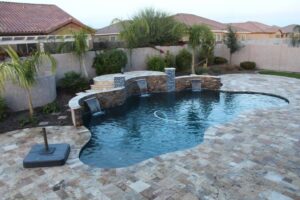Ecological Benefits of Interlock Repair for Leveling

The intersection of ecological sustainability and technological innovation is reshaping the landscape of interlock repair for leveling. By prioritizing both ecological benefits and technological advancements, homeowners and contractors can contribute to creating healthier, more sustainable outdoor environments while enhancing the longevity and functionality of interlocking stone surfaces.
While interlocking stones offer numerous aesthetic and functional benefits, they also contribute positively to the environment when properly repaired and maintained:
- Water Permeability: Interlocking stones allow water to permeate through the surface, reducing runoff and aiding in groundwater recharge. Proper leveling ensures that water drains efficiently, preventing erosion and minimizing the need for additional drainage systems.
- Heat Mitigation: Compared to traditional paved surfaces, interlocking stones have a lower heat absorption rate, helping to mitigate the urban heat island effect. This can contribute to cooler outdoor environments and reduce energy consumption for cooling purposes.
- Vegetation Integration: Interlocking surfaces can be designed to incorporate vegetation, such as grass or ground cover, within the gaps between stones. This green infrastructure promotes biodiversity, improves air quality, and enhances the overall ecological balance of outdoor spaces.
- Sustainable Materials: Many interlocking stones are made from sustainable materials, such as recycled concrete or natural stone. Repairing and maintaining these surfaces prolongs their lifespan, reducing the need for frequent replacements and conserving resources.
Advanced Technology in Interlock Repair
The field of interlock repair has seen significant advancements in technology, leading to more efficient and precise repair processes:
- 3D Laser Scanning: Advanced 3D laser scanning technology allows for precise measurements of interlocking surfaces, identifying even minor variations in elevation. This data helps in developing accurate repair plans and ensures uniform leveling across the entire surface.
- Computer-Aided Design (CAD): CAD software enables contractors to create detailed digital models of interlock surfaces and simulate repair scenarios. This digital planning improves the accuracy of repairs and reduces the margin for error during the execution phase.
- Polymeric Jointing Compounds: Modern polymeric jointing compounds offer superior durability and flexibility compared to traditional sand-based jointing materials. These compounds enhance the stability of interlocking stones, reducing the risk of displacement and minimizing maintenance requirements.
- Remote Monitoring and Maintenance: Some advanced interlock systems are equipped with sensors and remote monitoring capabilities. These systems can detect changes in surface elevation or integrity, allowing for proactive maintenance and timely repairs before issues escalate.
Integrating Sustainability and Technology
The future of interlock repair for leveling lies in the seamless integration of sustainability principles and cutting-edge technology:
- Green Infrastructure Design: Incorporating green infrastructure elements, such as permeable pavers and vegetated swales, into interlock repair projects can enhance environmental benefits while addressing leveling issues.
- Smart Repair Solutions: Utilizing smart sensors and IoT (Internet of Things) devices in interlock surfaces enables real-time monitoring of performance metrics, facilitating predictive maintenance and optimizing repair strategies.
- Recycled Materials Utilization: Advancing research and development efforts in utilizing recycled materials, such as reclaimed interlocking stones or composite aggregates, promotes circular economy practices within the interlock repair industry.
- Collaborative Research and Innovation: Encouraging collaboration between industry stakeholders, research institutions, and government agencies fosters innovation in sustainable interlock repair technologies and practices.
Embracing sustainable design principles, leveraging advanced technologies, and fostering collaboration across sectors are key strategies for ensuring efficient, resilient, and environmentally friendly interlock repair solutions.






